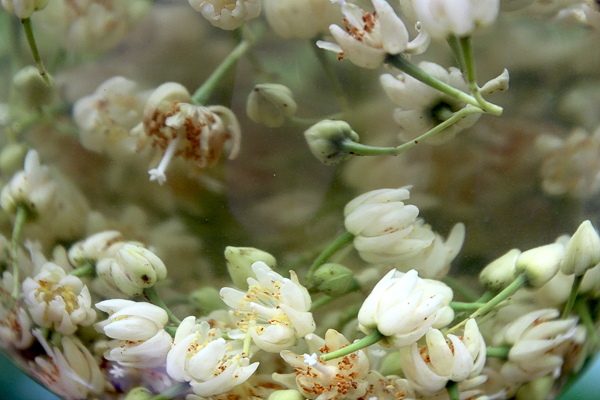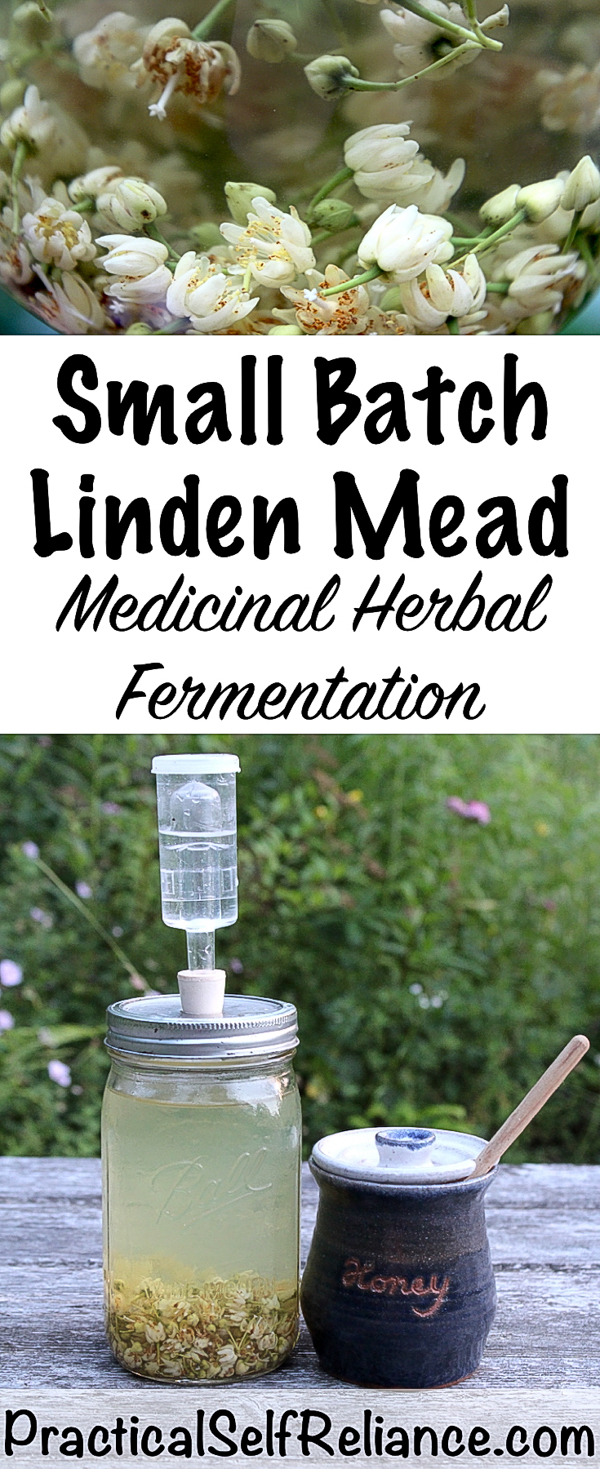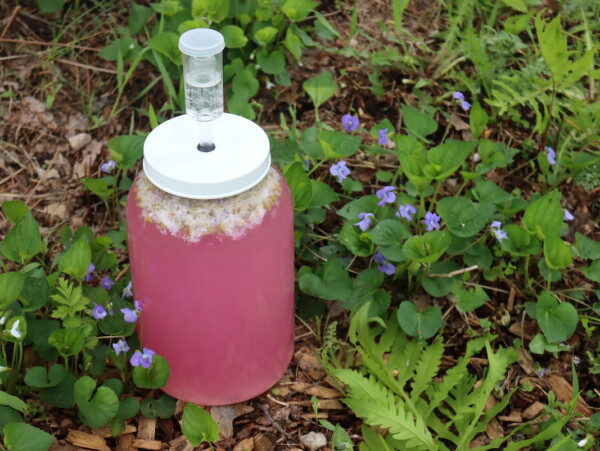Affiliate disclosure: This post may contain affiliate links. Please see our Privacy Policy.
Linden flowers are only up in the trees for about 2 weeks a year, but that’s just long enough to harvest a few handfuls for a wild foraged linden mead. The linden blossoms are used for stress, anxiety and insomnia which makes this brew especially helpful in a tiny cordial glass right before bed. Though it’s traditionally consumed as a linden tea, there’s no reason you can’t preserve your medicine in a tasty herbal mead.
Long ago, mead and ale were more than just a way get a buzz. Traditional herbalists made medicinal ferments as a way to preserve the medicinal properties of wild plants for use all year long.
Think of a mead as a combination of a herbal tea and a herbal tincture. A hot water decoction is used to pull out the water-soluble medicines, and then the alcohol later in the ferment pulls out the alcohol-soluble portions of the plant and preserves the whole batch.
I was inspired to make this herbal ferment after taking the Herbal Academy Craft of Herbal Fermentation Course this past year. I’m now signed up for their new Botany and Wildcrafting course starting in May 2018, so soon I’ll be identifying and wildcrafting new and exciting herbs for homemade mead!

There are a lot of great reasons to make a micro-batch mead. Linden blossoms often grow high up in the tree, and when you’re out foraging linden you can usually only reach a few handfuls. That makes them perfect for a small batch. I made this quart batch of linden mead using just a cup of linden flowers.
This mead can also be made with dried linden flowers or linden tea bags. With dried linden flowers, you need about 1/4 of a cup since they compress considerably when dried.
If using tea bags, use 3 to 4 linden tea bags. You can also try combining linden with a little bit of dried lemon balm for this mead because they have complementary tastes and medicinal properties.
All you need to start is a bit of honey, a handful of linden flowers, a quart mason jar, and a mason jar fermentation kit. There are a number of brands to choose from. Any of these will work.
I use a kit by Fermentools that looks a lot like a homebrew setup, and if you choose to do bigger batches later you’ll need the rubber stopper and water lock that are included in the kit.
I’m hoping at some point to try out these silicone fermentation lids from Mason Tops because they look super easy to clean.

Small Batch Linden Mead
In this recipe, we’re going to make one quart of mead. You can easily multiply this recipe by 4 to make a full gallon.
Start by adding about 1 cup of honey to the bottom of a quart mason jar. The basic instructions for a one-quart batch of mead have you add between 2/3 of a cup of honey and 1 cup of honey to get the right ratio of honey to water in your jar. Since this mead doesn’t have any fruit or another sweetener, feel free to use the full cup of honey for a sweet mead or make a dryer brew using only 2/3 of a cup.
When you’re making a fruit-based mead, like this small-batch raspberry mead, it’s important to reduce the total honey so that you don’t get a cloyingly sweet mead. With herbs, you can choose either a sweet or dry mead depending on your tastes.
Next, add the linden flowers into the jar with the honey.
Bring about 3 cups of water to a boil on the stove, then cool slightly for about 30 seconds before pouring it directly into the jar over the linden flowers and honey.
Stir to dissolve the honey, and then allow the whole jar to cool to room temperature before adding the yeast.
Once it’s cooled to room temperature, or at least cooled to 90 to 100 degrees so it won’t kill the yeast, add in a brewing yeast. For meads, I use packages of champagne yeast. One pack is enough to pitch a 5-gallon batch, so using the whole packet is overkill for a micro-batch.
I usually use about 1/4 of a yeast packet because it’s hard to actually extract less than that from a tiny packet. Dissolve it in room temperature chlorine-free water and pour it into your mason jar.
Related: How to Make One Quart of Mead (Micro Batch Method)
Once it’s all said and done, the quart mason jar should contain:
- 1 cup honey
- 1 cup of fresh linden flowers (or 1/4 cup dried linden flowers)
- a bit under 3 cups of water
- about 1/4 of a packet of champagne yeast
Be sure to leave about an inch of headspace to allow for expansion and bubbling during fermentation. Add on your mason jar fermentation kit and allow it to ferment at room temperature, out of direct sunlight for about 6 weeks.
The initial fermentation phase can be a bit intense, so after the first week if any of your herb material has made it into your water lock, pop it off and clean it out. Be sure to get it back on tight for the rest of your fermentation time.
When fermentation is complete, carefully pour off the mead into another jar, leaving the sediment behind.
I bottle mine, and allow it to age in grolsch bottles for at least 2 weeks, preferably a bit longer.
Then, enjoy!
If you’re looking for more details on how to make a one-quart batch of mead, you can read an introduction to the micro-batch method here.





Thanks for the recipe. How is the mouth feel of the linden flower mead? I tried using some linden flower in vodka and it became slimy, it wasn’t nice to drink.
I thought the mead came out wonderfully, but the flowers aren’t in there too long as to affect the texture. They just gave it a nice floral flavor.